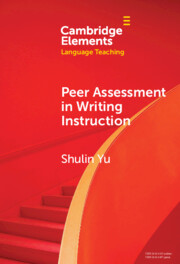Element contents
Peer Assessment in Writing Instruction
Published online by Cambridge University Press: 26 January 2024
Summary
- Type
- Element
- Information
- Series: Elements in Language TeachingOnline ISBN: 9781009429979Publisher: Cambridge University PressPrint publication: 04 April 2024
References
- 10
- Cited by

